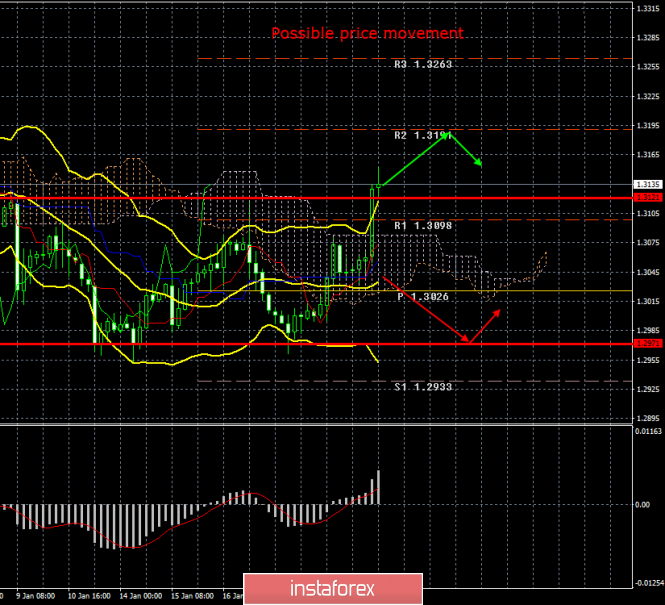4-hour time frame

Amplitude of the last 5 days (high-low): 58p - 57p - 115p - 52p - 89p.
Average volatility over the past 5 days: 75p (average).
The British pound unexpectedly increased for everyone and grew significantly on Wednesday, January 22. During the third trading day of the week, the pound / dollar currency pair managed to rise by 75 points. But the reason for such a strengthening of the British currency is difficult to say. There was not a single important macroeconomic publication in the UK or the States during the day. Donald Trump did not particularly touch upon Great Britain in his speeches in Davos, although we have heard promises of a deal with Boris Johnson more than once. In general, we believe that the pound has taken up its favorite thing again - to rise in price on rumors or unverified information or perhaps, the second option is another technical correction before a new, even stronger decline. It is most likely that the second option will be fulfilled, although at the moment most of the indicators already signal an upward trend, so now it is recommended to wait for the trend to change to a downward one and only then resume selling the British currency.
As for the fundamental background, it remains the same for obvious reasons. The House of Lords rejected a bill by Boris Johnson on a deal with the European Union and Brexit, but this will not change anything. Brexit can no longer be canceled, and Boris Johnson will rule the country almost single-handedly in the coming years. Thus, the "Damocles sword" still hangs over the pound in the form of uncertainties related to the consequences of Brexit, with negotiations with the European Union on trade relations. However, all this is lyrics so far. Now, the pound needs to be afraid of macroeconomic statistics, as well as the meeting of the Bank of England, which will be held next week. Macroeconomic statistics, as well as simple finances, only indicate that the UK economy continues to lose money, continues to lose investment. The experts counted first, how much Brexit will cost the UK - the figure was more than 200 billion pounds. And a little later it was estimated that she paid contributions in the amount of 215 billion pounds for 47 years of British membership in the EU. That is, the last three years of "divorce" with the Alliance cost the British about the same as 47 years of membership in the European Union. So, dear traders, Jjdge for yourself about these numbers.
What is positive for the British pound? There is little positivity. Macroeconomic data on wages and unemployment cannot level all the losses that Britain has already suffered and will continue to suffer. It cannot level the losses of the rest of the failed statistics, where inflation and GDP are. Therefore, every time we see a strong strengthening of the pound, we look at this phenomenon with skepticism, realizing that it will be followed by a 90% probability drop. In principle, the current growth of the pair may not mean that the pound began to grow in the literal sense of the word. It may mean that some of the short positions were closed in the currency market, or some bank entered the market with a major transaction, which caused a bias in supply and demand for the pound on January 22. In any case, pullbacks and corrections are needed, but traders can use them for more profitable sales of the British currency.
From a technical point of view, we are expecting a correction at the moment against the upward trend that has formed in recent days. We also assume that the upward movement in the last few days will end today. However, we still do not recommend "catching reversals" . We consider it more advisable to wait until the quotes of the pound / dollar pair are fixed below the critical line, and then resume selling the British currency.
Trading recommendations:
GBP/USD has temporarily postponed the downward trend option. Thus, traders are advised to resume sales of the pound / dollar pair with targets at 1.2971 and 1.2933 after completing the correction and fixing the pair below the Kijun-sen line. The pair's purchases are formally relevant now with the goal of the resistance level of 1.3191. However, we do not see logical reasons for continuing the strengthening of the British currency.
Explanation of the illustration:
Ichimoku indicator:
Tenkan-sen is the red line.
Kijun-sen is the blue line.
Senkou Span A - light brown dotted line.
Senkou Span B - light purple dashed line.
Chikou Span - green line.
Bollinger Bands Indicator:
3 yellow lines.
MACD indicator:
Red line and bar graph with white bars in the indicators window.
Support / Resistance Classic Levels:
Red and gray dashed lines with price symbols.
Pivot Level:
Yellow solid line.
Volatility Support / Resistance Levels:
Gray dotted lines without price designations.
Possible price movements:
Red and green arrows.
The material has been provided by InstaForex Company - www.instaforex.com